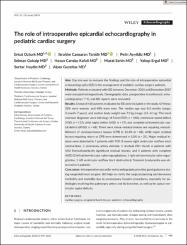The role of intraoperative epicardial echocardiography in pediatric cardiac surgery

View/
Date
2018Author
Öztürk, ErkutCansaran Tanıdır, İbrahim
Ayyıldız, Pelin
Gökalp, Selman
Candaş Kafalı, Hasan
Şahin, Murat
Ergül, Yakup
Haydin, Sertaç
Güzeltaş, Alper
Metadata
Show full item recordAbstract
Aim: Our aim was to evaluate the findings and the role of intraoperative epicardial
echocardiography (IEE) in the management of pediatric cardiac surgery patients.
Methods: Patients evaluated with IEE between December 2015 and December 2017
were analyzed retrospectively. Demographic data, preoperative transthoracic echocardiography (TTE), and IEE reports were evaluated.
Results: A total of 410 patients evaluated by IEE were included in the study. Of these,
52% were women, and 48% were men. The median age was 8.5 months (range:
1 month–7 years), and median body weight was 7.1 kg (range: 3.3–61 kg). The most
common diagnoses were tetralogy of Fallot (TOF; n = 148), ventricular septal defect
(VSD; n = 117), atrial septal defect (ASD; n = 57), and complete atrioventricular septal defect (AVSD; n = 48). There were minor residual lesions not requiring reestablishment of cardiopulmonary bypass (CPB) in 16.6% (n = 68), while major residual
lesions requiring return to CPB were determined in 5.1% (n = 21). Major residual lesions were detected in 7 patients with TOF (4 severe right ventricular outflow tract
obstructions, 2 pulmonary artery stenosis, 1 residual VSD shunt), 6 patients with
VSD (hemodynamically significant residual shunts), and 5 patients with complete
AVSD (3 left atrioventricular valve regurgitations, 1 right atrioventricular valve regurgitation, 1 left ventricular outflow tract obstruction). Transient bradycardia was observed in 5 patients.
Conclusion: Intraoperative epicardial echocardiography provides good guidance during congenital heart surgery. IEE helps to clarify the surgical planning and decreases
morbidity and mortality due to unnecessary invasive procedures, especially for pathologies involving the pulmonary artery and its branches, as well as for apical ventricular septal defects.
















